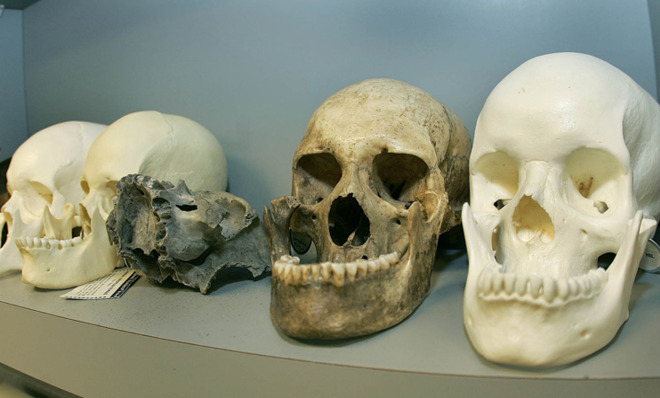The secret language of skulls
The distance between your left frontomalare and left dacryon can reveal a whole lot about you

Every skull has a story to tell. And if the skull ends up on Ann Ross' desk, the story is usually an ugly one.
Ross is a state-employed forensic anthropologist and co-director of the Forensic Sciences Institute at North Carolina State University. As a specialist in hard tissue and bones, she is often called upon to identify remains that lack clothing, tissue, or other clues that might help investigators match a body with a missing persons report. Basically, she's the specialist you've seen called onto cases on CSI, Bones, Law & Order, Dexter, Cold Case, Criminal Minds and a dozen other crime dramas that color our perception of forensic science. And you'd be amazed what she can tell you about a person just by looking at their toothless skull.
A few years ago, Ross and her colleagues invented a piece of software, called 3D-ID, that compares digital scans of unidentified skulls to a database of other skulls. What comes back is eerily specific. For instance, Ross' software might reveal not only that a skull belonged to a Latino male, but that the man's ancestors came from South America, as opposed to a Latino man descended from Mesoamerica or the Caribbean.
The Week
Escape your echo chamber. Get the facts behind the news, plus analysis from multiple perspectives.

Sign up for The Week's Free Newsletters
From our morning news briefing to a weekly Good News Newsletter, get the best of The Week delivered directly to your inbox.
From our morning news briefing to a weekly Good News Newsletter, get the best of The Week delivered directly to your inbox.
Unfortunately, this example is not chosen at random. "We have a huge crisis happening right now in the United States," said Ross. "Undocumented individuals are trying to get into the U.S. to build a better future, but many of these people are dying at the border."
One side effect of the television shows mentioned earlier is that we tend to think forensic teams spend most of their days investigating eccentric serial killers. In reality, Ross and her ilk also play an important role in immigration issues, war crime investigations, and natural disasters.
On top of that, the National Institute of Justice says there are approximately 100,000 missing persons in the United States at any given time. From the abducted child all over the evening news to the sex worker you'll never even hear about, too many of the missing will one day end up on a forensic anthropologist's table.
However, thanks to 3D-ID, specimens that might have once been just another dead end, pardon the phrase, are now potential resources. To Ross, something as subtle as the distance between the left frontomalare and the left dacryon — two craniofacial landmarks on either side of your eye socket — might be the clue that breaks open a case.
A free daily email with the biggest news stories of the day – and the best features from TheWeek.com
"People go missing all the time," said Ross. "Bodies are not found, or they end up in different states. One of the things we're trying to do is to bring the people that deal with these medical and legal issues together so that we can work to bring closure to the families."
One way Ross' research makes this possible is by providing access to 3D-ID completely free of charge. She and her colleagues also work to train other people in their field on how to use the software. Ross said at least one forensic anthropologist in Florida has already incorporated the program into all of her protocols, since her cases often involve people of various Latino descents.
Of course, 3D-ID still has its drawbacks. For one, it needs more skulls. Ross has been building the database one museum collection of desiccated heads at a time, but it's not like there's some massive pile of skull scans she can simply tap into. A colleague in the Czech Republic recently donated scans from over 1,000 skulls, thereby doubling 3D-ID's reference database and fleshing out profiles for many different lineages of Europeans.
But the biggest contribution to the database may yet come from living humans. Ross and her colleagues recently experimented with measuring the skulls of people who had undergone everyday CT scans. She found it takes some legwork to digitally pare away all the layers of skin and muscle on a human face, but the results were promising. Ross says the study may even help craniofacial surgeons tasked with rebuilding a person's face. (Their findings were published in the January issue of The Journal of Craniofacial Surgery.)
The hope is obviously that none of us will ever have to benefit from the kind of research Ross does, though this might be the only true way to appreciate its impact.
Last year, Ross' testimony helped solve the case of a woman who had been missing for over 30 years. The woman left behind a young boy, no more than eight or nine. The boy, now a middle-aged man, also testified in the case, saying that he'd been told his mom left because she didn't love him anymore.
"He grew up with that void thinking his mother left him," said Ross, "when in fact his mom had been murdered — by his stepfather."
Every skull is a person. Every skull is a story.
Jason Bittel serves up science for picky eaters on his website, BittelMeThis.com. He writes frequently for Slate and OnEarth. And he's probably suffering from poison ivy as you read this.
-
 The UK’s best Christmas pantos
The UK’s best Christmas pantosThe Week Recommends Dive into the festive cheer, even into the new year, with some traditional favourites and modern twists
-
 The longevity economy is booming as people live longer
The longevity economy is booming as people live longerThe Explainer The sector is projected to reach $27 trillion by 2030
-
 Codeword: December 11, 2025
Codeword: December 11, 2025The daily codeword puzzle from The Week